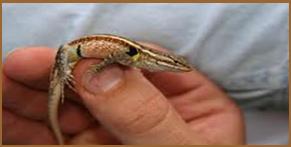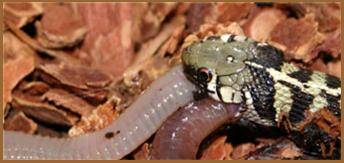Guide to SA Natural Areas & Greenway Trails
G. Area Reptiles

Rosebelly Lizard (picture by author)
Fred Wills is the author of this piece.
REPTILE = TERRESTRIAL VERTEBRATE WITH SCALES OR PLATES
Animals with backbones (vertebrates) fall into several classes. We all recognize feathered birds and hairy mammals. But what is a reptile? An easy definition of reptiles is that they are terrestrial, vertebrate animals with scales or plates covering the body. However, this definition simplifies their great diversity. In Texas alone, there are four major groups of reptiles: lizards, snakes, turtles, and crocodilians (alligators). Hardberger Park is home to lizards, snakes, and turtles.
PHIL HARDBERER PARK: ROSEBELLY LIZARD, TEXAS SPINY LIZARD, GROUND SKINK, TEXAS RAT SNAKE, ROUGH EARTH SNAKE & ROUGH GREEN SNAKE
Common lizards of the park include the Rosebelly Lizard, Texas Spiny Lizard, and Ground Skink. Common snakes of the park include the Texas Rat Snake, Rough Earth Snake, and Checkered Garter Snake. Can you name any other lizards and snakes found in the area? Hint: One lizard can change color, and one snake can produce sound.
Like many birds and mammals, reptiles are predators. Small ones like the Rosebelly Lizard and Rough Earth Snake eat invertebrate animals such as insects. Medium-sized snakes such as the Checkered Garter Snake often eat frogs. Larger snakes, including the Texas Rat Snake, typically eat small mammals and birds.
Where do reptiles live? The various species occupy almost all kinds of habitats, from dry prairie to moist woodland, and even wetlands and streams. Related species often divide up the habitat through differing behaviors. Two kinds of fence lizards, the Rosebelly Lizard and Texas Spiny Lizard, differ not just in size but also in their preference for living on the ground versus living in the trees. The Rosebelly Lizard is smaller and found on the ground. The larger Texas Spiny Lizard is frequently seen in trees, but will sometimes descend to the ground.
Both of these lizards have rough scales. The Ground Skink is a small, shiny, snake-like lizard that lives among fallen leaves and grasses. Its smooth scales and tiny limbs allow it to slip easily away if pursued by a predator. Some reptiles even live in the ground. The Texas Blind Snake is worm-like, lives in the soil, and feeds on ant eggs, larvae and pupae. Using a noxious secretion, it can even repel an attack by ants.
REPTILES CANNOT REGULATE BODY TEMPERATURE
Reptiles, unlike birds and mammals, cannot maintain a constant body temperature. They must move into or out of warm or cool areas in order to keep their bodies at the right temperature. Why might this be an advantage compared to animals that maintain constant temperature using their physiology?
CAMOUFLAGE
Skin color in reptiles varies from dull browns and grays to striking bright green. Background-matching skin color or the ability to change skin color is an example of camouflage. The Texas Spiny Lizard’s brownish, mottled skin blends well with tree bark, allowing it to remain concealed while in the open. The Green Anole has the ability to change from green to brown and back. This often makes the animal nearly invisible among leafy trees and vines.
The majority of snakes are non-poisonous, but even poisonous snakes are of little concern if proper precautions are taken. To avoid potential problems, do not handle unidentified or poisonous snakes, do not put your hands or feet in places you cannot see, be aware of your surroundings (like the trail surface and what might be on it), wear boots when off-trail, and use a light at night. While you may not see reptiles as you walk along the trail, know that Phil Hardberger Park provides a home for this interesting group of vertebrates.

Author’s picture of Checkered Garter Snake eating an earthworm.